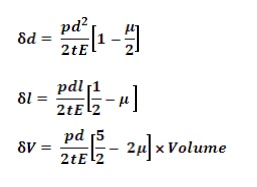Chapter: Mechanical : Strength of Materials : Transverse Loading On Beams And Stresses In Beam
Important Answers: Transverse Loading on Beams and Stresses in Beam
TRANSVERSE LOADING ON BEAMS AND STRESSES
IN BEAMS
1. State
the assumptions while deriving the general formula for shear stresses.
i. The
material is homogenous, isotropic and elastic.
ii. The
modulus of elasticity in tension and compression are same and the shear stress
is constant along the beam width.
2.Define shear stress
distribution.
The variation of shear stress along the
depth of beam is called shear stress distribution.
3. Mention the
different types of beams.
i.
Cantilever beam,
ii.
Simply supported beam,
iii.
Fixed beam,
iv.
Continous beam and
v.
Over hanging beam
4. Write down the
bending moment equation.
The bending equation M /I = σ/y =E/R
Where,
M
–bending moment
I
–moment of inertia of the section,
σ–bending stress at that
section,
y
–distance from the neutral axis,
E
–Young’s modulus of
the material,
R
–radius of curvature of the beam.
5. What do you understand by the term
point of contraflexure?
The
point where the shear force changes its sign or zero is called as point of
contraflexure.At this point the bending moment is maximum.
6. What is the
value of bending moment corresponding to a point having a zero shear force?
The
value of bending moment is maximum where the shear force changes it sign or
zero.
7. Mention the
types of supports.
Roller support
Fixed support
Hinged or pinned support
8. Define bending
moment in beam.
The
bending moment of the beam may be defined as the algebraic sum of the moments
of the forces,
to the right or left of the section.
9. Define shear force.
Shear
force at any section is defined as the algebraic sum of all forces acting on
either side of a
beam.
10. What is meant by
Neutral axis of the beam?
It
is an imaginary plane, which divides the section of the beam into the tension
and compression zones on the opposite sides of the plane.
11.
What is mean by compressive and tensile force?
The forces in the
member will be compressive if the member pushes the joint to which it is connected
whereas the force in the member will be tensile if the member pulls the joint
to which it is connected.
12.
How will you determine the forces in a member by method of joints?
In method of joint
after determining the reactions at the supports, the equilibrium of every
support is considered. This means the sum all vertical forces as well as the
horizontal forces acting on a joint is equated to zero. The joint should be
selected in such a way that at any time there are only two members, in which the
forces are unknown.
13. What are the benefits of method of
sections compared with other methods?
1. This
method is very quick
2. When
the forces in few members of the truss are to be determined, then the method of
section is mostly used.
14. Define thin cylinder?
If the thickness of the
wall of the cylinder vessel is less than 1/15 to 1/20 of its internal diameter,
the cylinder vessel is known as thin cylinder.
15. What are types of
stress in a thin cylindrical vessel subjected to internal pressure?
These stresses are
tensile and are know as
Circumferential stress (or hoop
stress )
Longitudinal stress
16.
What is mean by circumferential stress (or hoop stress) and longitudinal
stress?
The stress
acting along the
circumference of the
cylinder is called circumferential stress
(or
hoop
stress) whereas the stress acting along the length of the cylinder is known as
longitudinal stress.
17.
What are the formula for finding circumferential stress and longitudinal
stress?
Circumferential
stress, f1 = pd / 2t
longitudinal stress, f2 = pd / 4t
18. What are maximum shear stresses at
any point in a cylinder?
Maximum shear stresses
at any point in a cylinder, subjected to internal fluid pressure is given by (f1
–f2) / 2 = pd / 8t
19. What are the formula for finding
circumferential strain and longitudinal strain?
The circumferential strain (e1)
and longitudinal strain (e2) are given by

19. What are the formula for finding
change in diameter, change in length and change volume of a cylindrical shell
subjected to internal fluid pressure p?

Related Topics